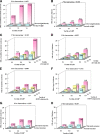A marker of endotoxemia is associated with obesity and related metabolic disorders in apparently healthy Chinese
- PMID: 20530747
- PMCID: PMC2928335
- DOI: 10.2337/dc10-0340
A marker of endotoxemia is associated with obesity and related metabolic disorders in apparently healthy Chinese
Abstract
Objective: Elevated lipopolysaccharide-binding protein (LBP), a marker of subclinical endotoxemia, may be involved in the pathogenesis of obesity and metabolic risk. We aimed to investigate the association between plasma LBP and metabolic disorders in apparently healthy Chinese.
Research design and methods: A population-based study including 559 overweight/obese (BMI >or=24.0 kg/m(2)) and 500 normal-weight (18.0 <or= BMI <24.0 kg/m(2)) subjects aged 35-54 years was conducted in Shanghai, China. Fasting plasma glucose, lipid profile, LBP, high-sensitivity C-reactive protein, interleukin-6, high-molecular-weight (HMW) adiponectin, leptin, hepatic enzymes, and body composition were measured. Metabolic syndrome was defined by the updated National Cholesterol Education Program Adult Treatment Panel III criterion for Asian Americans.
Results: LBP levels were significantly higher in overweight/obese individuals than in normal-weight individuals (geometric mean 27.6 [95% CI 25.2-30.3] vs. 10.0 [9.1-11.1] microg/ml; P < 0.001). After multiple adjustments including BMI, the odds ratios were 3.54 (95% CI 2.05-6.09) and 5.53 (95% CI 2.64-11.59) for metabolic syndrome and type 2 diabetes, respectively, comparing the highest with the lowest LBP quartile. Further adjustments for inflammatory markers almost abolished the significant association of LBP with metabolic syndrome but not that with type 2 diabetes, and controlling for adipokines and hepatic enzymes did not substantially alter the results.
Conclusions: Elevated circulating LBP was associated with obesity, metabolic syndrome, and type 2 diabetes in apparently healthy Chinese. These findings suggested a role of lipopolysaccharide via initiation of innate immune mechanism(s) in metabolic disorders. Prospective studies are needed to confirm these results.
Figures

References
-
- World Health Organization. Obesity and overweight: Fact Sheet No. 311 [article online], 2006. Available from http://www.who.int/mediacentre/factsheets/fs311/en/print.html/. Accessed 26 October 2007
-
- Dandona P, Aljada A, Chaudhuri A, Mohanty P, Garg R: Metabolic syndrome: a comprehensive perspective based on interactions between obesity, diabetes, and inflammation. Circulation 2005;111:1448–1454 - PubMed
-
- Wiedermann CJ, Kiechl S, Dunzendorfer S, Schratzberger P, Egger G, Oberhollenzer F, Willeit J: Association of endotoxemia with carotid atherosclerosis and cardiovascular disease: prospective results from the Bruneck Study. J Am Coll Cardiol 1999;34:1975–1981 - PubMed
-
- Cani PD, Bibiloni R, Knauf C, Waget A, Neyrinck AM, Delzenne NM, Burcelin R: Changes in gut microbiota control metabolic endotoxemia-induced inflammation in high-fat diet-induced obesity and diabetes in mice. Diabetes 2008;57:1470–1481 - PubMed
-
- Cani PD, Amar J, Iglesias MA, Poggi M, Knauf C, Bastelica D, Neyrinck AM, Fava F, Tuohy KM, Chabo C, Waget A, Delmée E, Cousin B, Sulpice T, Chamontin B, Ferrières J, Tanti JF, Gibson GR, Casteilla L, Delzenne NM, Alessi MC, Burcelin R: Metabolic endotoxemia initiates obesity and insulin resistance. Diabetes 2007;56:1761–1772 - PubMed
Publication types
MeSH terms
Substances
Grants and funding
LinkOut - more resources
Full Text Sources
Other Literature Sources
Medical
Research Materials
Miscellaneous

